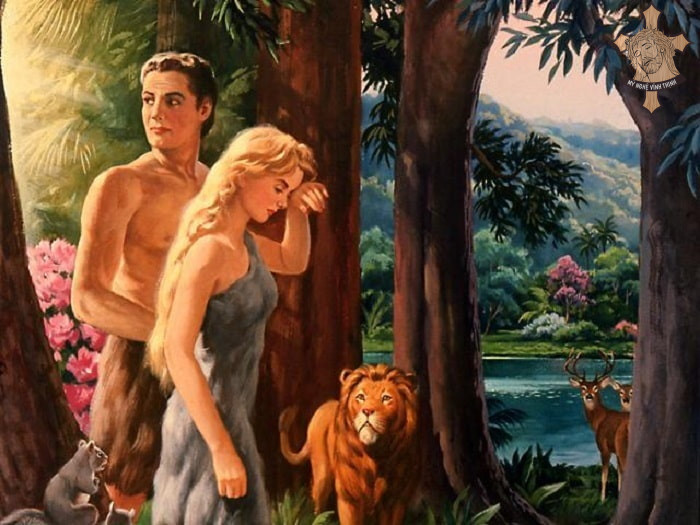As a centerpiece of Abrahamic religious tradition, Garden of Eden serves as a compelling symbol, a canvas upon which timeless narratives about human nature, morality, and the divine are illustrated. Set within the earliest chapters of the Book of Genesis in the Hebrew Bible and the Christian Old Testament, the Garden is characterized as a divine creation of unparalleled beauty and abundance, a paradisiacal habitat designed for the first humans, Adam and Eve.
Brimming with lush vegetation, it is the original stage for humanity’s encounter with morality and the consequences of choice. Here, in this idyllic setting, the first act of disobedience is played out, leading to the introduction of sin and the consequent expulsion of Adam and Eve. The narrative presents us with two specific trees: the Tree of Life and the Tree of Knowledge of Good and Evil, each adding profound layers of symbolism to the Edenic tableau.
What is the Garden of Eden?
The Garden of Eden is a location of critical significance in the traditions of the Abrahamic religions, notably Judaism, Christianity, and Islam. The term itself emanates from the Hebrew words ‘gan,’ meaning ‘garden,’ and ‘eden,’ which can be translated as ‘delight’ or ‘pleasure.’ This setting is most prominently described in the Book of Genesis in the Hebrew Bible and the Old Testament of the Christian Bible, where it is presented as the place created by God for the first humans, Adam and Eve.
In the Biblical narrative, the Garden of Eden is depicted as an idyllic habitat, lush with vegetation and brimming with animals. It is understood to be a paradisiacal place, where all needs of Adam and Eve were met without any necessity for labor. It is characterized as being populated with all kinds of trees desirable to the sight and good for food. Notably, it is also the home to two particular trees: the Tree of Life and the Tree of Knowledge of Good and Evil.
The narrative in Genesis 2–3 contains the story of Adam and Eve’s disobedience to God’s command, which results in their expulsion from the Garden. This disobedience involved eating the fruit from the Tree of Knowledge of Good and Evil, which led to the awareness of their nakedness and, symbolically, the inception of human sin.
In Islamic tradition, the Garden of Eden (Jannah in Arabic) is an archetypal paradise, but it is not specifically identified as the place of Adam and Eve’s dwelling before their fall. This narrative is found in various passages throughout the Qur’an.
On a symbolic level, the Garden of Eden often stands for innocence, bliss, a prelapsarian state, and a desire to return to an uncorrupted existence. Its cultural and theological implications are profound, affecting the way the themes of sin, redemption, and the nature of human beings are interpreted in the Abrahamic religions.
Where is the Garden of Eden located?
The exact geographical location of the Garden of Eden, as described in the religious texts of Judaism, Christianity, and Islam, remains a matter of considerable speculation and debate. The description given in the Book of Genesis in the Hebrew Bible and the Old Testament of the Christian Bible is notably broad and somewhat ambiguous.
According to the Genesis account, the Garden of Eden was situated at the source of four rivers: the Pishon, the Gihon, the Tigris (Hiddekel in Hebrew), and the Euphrates. The latter two are identifiable as real rivers flowing through modern-day Iraq and Turkey. The identification of the Pishon and Gihon rivers, however, is much more problematic and uncertain. Various suggestions have been put forth, with scholars proposing diverse locations, including the Nile in Egypt and other rivers in Mesopotamia, the Arabian Peninsula, and even the Caucasus region.
Given these ambiguities, interpretations of the Garden’s location vary significantly. Some propose a location in Mesopotamia, the fertile area between the Tigris and Euphrates rivers, which is historically known as the cradle of civilization. Others suggest a location in the Armenian Highlands, close to the sources of the Tigris and Euphrates, and aligning with other descriptions in Genesis. Yet another theory posits that the Garden was located in the southern Arabian Peninsula, where the now-dry riverbeds could correspond to the biblical Pishon and Gihon.
In the Islamic tradition, the Garden of Eden is more metaphorically than geographically defined. While the Qur’an describes a paradisiacal garden where Adam and Eve lived before their fall, it does not specify an earthly location for this garden.
In the realm of historical and archaeological scholarship, it is generally recognized that the Garden of Eden, if it existed, remains beyond our ability to physically locate. Its importance, therefore, lies not in its geographical reality, but in its theological, symbolic, and cultural significance within these religious traditions.
Characteristics of Garden of Eden
The Garden of Eden is characterized by several distinctive attributes:
- Divine Creation: The Garden of Eden is created by God, illustrating divine power and wisdom. It is an integral part of the creation narrative, manifesting God’s benevolence toward humanity.
- Geographical Placement: The text provides geographical references to the Garden’s location, stating it was in the East and naming four rivers — Pishon, Gihon, Tigris (Hiddekel), and Euphrates — that flowed from it. However, the exact location remains elusive.
- Abundance and Beauty: The Garden is described as being lush with “every tree that is pleasant to the sight and good for food” (Genesis 2:9), symbolizing a place of abundance, sustenance, and aesthetic beauty.
- The Tree of Life and the Tree of Knowledge of Good and Evil: These two specific trees are singled out in the narrative. The Tree of Life symbolizes eternal life, while the Tree of Knowledge of Good and Evil represents the moral boundary set by God.
- The First Habitat of Humans: The Garden of Eden is described as the original dwelling place of the first humans, Adam and Eve, illustrating the initial harmony between humans and nature, and the direct communion between humans and God.
- The Presence of Animals: The narrative recounts the presence of “every beast of the field and every bird of the heavens,” indicating a peaceful cohabitation of humans and animals.
- The Serpent’s Habitation: The Garden was also home to the serpent, traditionally interpreted as Satan or a representation of evil, marking the introduction of deceit and temptation into the human experience.
- Paradisiacal Ideal: The Garden of Eden is depicted as a paradise, a place of perfect peace, innocence, and bliss before the fall of humanity.
- Site of the Fall: The Garden is the setting for the first disobedience of God’s command, leading to the awareness of nakedness, the inception of sin, and the expulsion of Adam and Eve.
These characteristics together contribute to the Garden of Eden’s rich symbolism and its representation of both the ideal state of existence and the complexities of the human condition.
Is the Garden of Eden a real place?
The question of the Garden of Eden’s existence as a real, physical location is a complex one, intertwined with theological interpretation, historical context, and archaeological evidence, and the answer depends largely on one’s perspective.
From an archaeological and historical perspective, there is currently no concrete evidence to support the existence of the Garden of Eden as a specific geographical location. Although the Book of Genesis describes it as being at the source of four rivers, including the Tigris and the Euphrates, attempts to locate the Garden based on this description have been inconclusive. This is due to the ambiguity of the other two rivers mentioned (the Pishon and the Gihon) and the fact that river courses, particularly in a region as geologically active as the Middle East, can change significantly over thousands of years.
From a theological perspective, interpretations vary widely. Some people, particularly among conservative religious groups, hold a literalist interpretation of the Bible and believe that the Garden of Eden was a real, physical place. Others, however, interpret the story of Adam, Eve, and the Garden of Eden allegorically or symbolically. They view it as a theological construct designed to convey important truths about God, humanity, and the nature of good and evil, rather than as a historical account.
In academic religious studies, the narrative of the Garden of Eden is often considered within the broader context of ancient Near Eastern literature. Similar themes of a lost paradise can be found in other cultures of the region, suggesting that the story may be part of a larger, regional mythological tradition.
Meaning of the Garden of Eden in religious texts
The Garden of Eden plays a significant role in the religious texts and theological interpretations of the Abrahamic traditions: Judaism, Christianity, and Islam. It serves as a setting of immense symbolic and allegorical weight, informing various understandings of morality, human nature, and the relationship between humans and the divine.
In the Hebrew Bible and the Christian Old Testament, the Garden of Eden narrative is found in the Book of Genesis. The Garden is depicted as a divine creation, a place of initial harmony and perfection where the first humans, Adam and Eve, coexisted peacefully with nature and had direct communion with God. The Garden is representative of an ideal state of being, a utopia, signifying innocence, purity and complete sustenance.
However, the narrative is fundamentally a story of disobedience and fall, where Adam and Eve, tempted by the serpent, eat from the Tree of Knowledge of Good and Evil against God’s command. This act leads to their expulsion from the Garden. Consequently, the Garden also symbolizes the loss of innocence and the introduction of sin into human existence. The expulsion from the Garden underlines the consequences of disobedience, marking humanity’s fall from divine grace and the onset of mortality, labor and suffering.
In Christian interpretation, the Garden of Eden narrative prefigures the need for salvation and redemption through Jesus Christ. The sin of Adam and Eve, often termed as the ‘Original Sin,’ is understood as an inherited condition that affects all of humanity. Christ’s sacrificial death and resurrection are perceived as the means to overcome this condition and restore the broken relationship between God and humanity.
In Islamic tradition, the Qur’an presents a similar narrative about the first humans dwelling in a paradisiacal garden and being expelled due to disobedience. While the Qur’an does not explicitly name this place as the Garden of Eden, the implications are quite parallel. However, the Islamic perspective diverges from the Christian understanding of original sin, emphasizing individual responsibility for one’s actions rather than inherited guilt.
In all these contexts, the Garden of Eden functions as a powerful symbol of both an ideal existence and the complexities of the human condition—highlighting themes of disobedience, punishment, moral awareness, and the longing for a lost paradise. As such, it continues to play a profound role in shaping theological discourse and ethical understandings in these religious traditions.









